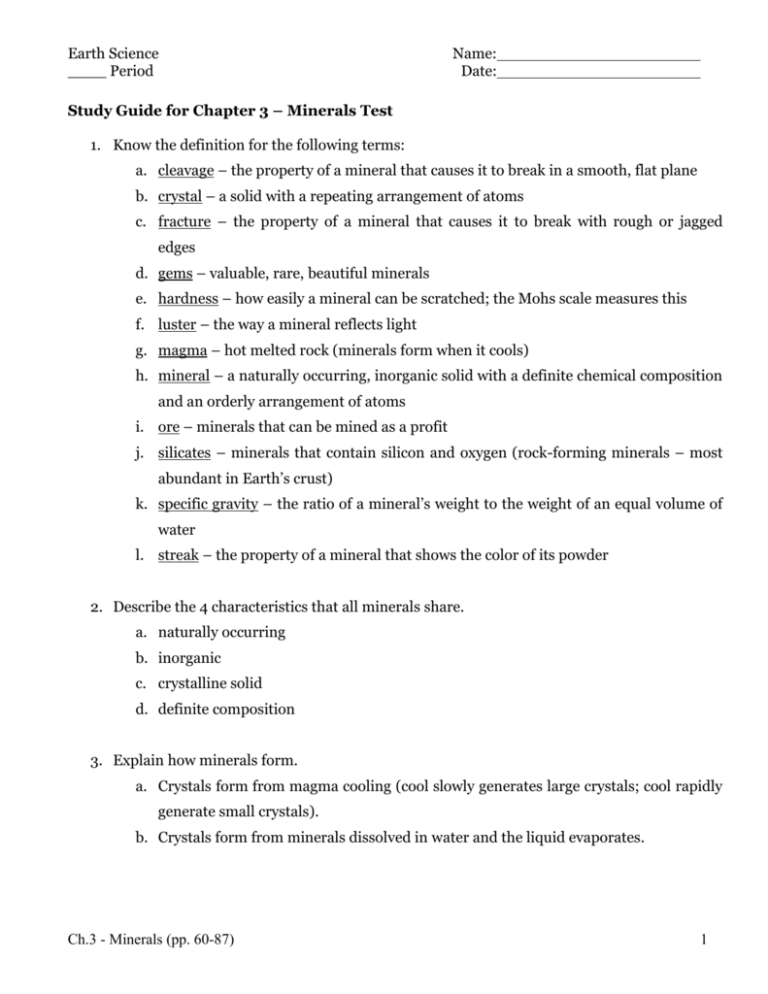Study Guide for Chapter 3 – Minerals Test
advertisement

Earth Science ____ Period Name: Date: Study Guide for Chapter 3 – Minerals Test 1. Know the definition for the following terms: a. cleavage – the property of a mineral that causes it to break in a smooth, flat plane b. crystal – a solid with a repeating arrangement of atoms c. fracture – the property of a mineral that causes it to break with rough or jagged edges d. gems – valuable, rare, beautiful minerals e. hardness – how easily a mineral can be scratched; the Mohs scale measures this f. luster – the way a mineral reflects light g. magma – hot melted rock (minerals form when it cools) h. mineral – a naturally occurring, inorganic solid with a definite chemical composition and an orderly arrangement of atoms i. ore – minerals that can be mined as a profit j. silicates – minerals that contain silicon and oxygen (rock-forming minerals – most abundant in Earth’s crust) k. specific gravity – the ratio of a mineral’s weight to the weight of an equal volume of water l. streak – the property of a mineral that shows the color of its powder 2. Describe the 4 characteristics that all minerals share. a. naturally occurring b. inorganic c. crystalline solid d. definite composition 3. Explain how minerals form. a. Crystals form from magma cooling (cool slowly generates large crystals; cool rapidly generate small crystals). b. Crystals form from minerals dissolved in water and the liquid evaporates. Ch.3 - Minerals (pp. 60-87) 1 Earth Science ____ Period Name: Date: 4. How are crystals of minerals classified? a. They are classified by the shapes produced by the internal arrangement of their atoms b. cubic, hexagonal, tetragonal, orthorhombic, monoclinic, and triclinic 5. Describe physical properties used to identify minerals. a. hardness b. luster c. streak d. specific gravity e. cleavage f. fracture g. crystal shape h. color i. unique properties like magnetism, fizzes with acid 6. Identify minerals using the Mohs Scale. Use “Name that Mineral” WS p 61 to practice this skill. Ch.3 - Minerals (pp. 60-87) 2 Earth Science ____ Period Name: Date: 7. Describe characteristics of gems that make them more valuable than other minerals. a. They are rare and beautiful (clearer, brighter, more colorful). 8. Identify useful elements that are contained in minerals. a. Iron in quartz gives amethyst its purple color. b. Iron in garnet gives almandine its red color. c. Iron or titanium in corundum gives sapphires their blue color. d. Chromium in corundum gives rubies their red color. e. Iron can come from hematite and magnetite ore. f. Aluminum comes from bauxite ore. g. Zinc comes from vein minerals of sphalerite. h. Titanium comes from vein mineral deposits and igneous rock that contains the minerals ilmenite and rutile. 9. Why are minerals important? a. We use minerals every day. (Ceramic, metals, paper, glass, bricks, bike racks, toothpaste, and health supplements etc). 10. Why is it important to identify minerals? a. Identifying minerals helps you recognize valuable mineral resources. 11. What are minerals used for? a. Minerals are necessary materials for decorative items (jewelry) and many manufactured products (aluminum used in bike racks, cooking foil; titanium used in lightweight wheelchairs, prosthetic limbs, automobile and aircraft manufacturing, eyeglass frames; iron used in construction, frying pans, ships; quartz used in electronics, timepieces, lasers) Ch.3 - Minerals (pp. 60-87) 3 Earth Science ____ Period Name: Date: Minerals some uses some properties of Streak Cleavage and fracture Ore which means which means which means which is The way a mineral reflects light Color of a mineral in powdered form The way a mineral breaks Hardness Luster which means How easily a mineral is scratched Ch.3 - Minerals (pp. 60-87) Gem A useful substance mined for profit 4 which is A rare and beautiful mineral






